
How To Write A ToK Essay - Updated 2023
Ace your ToK Essay with our expert tips & tricks! Get the latest and greatest techniques on "How To Write A ToK Essay" and impress the IB examiners.📝💡

Table of content
Purpose of tok, assessment of tok, the game plan, execution of the gameplan, planning for tok essay, structure of tok essay, introduction, conclusions, bibliography.
How to write a TOK Essay?
To answer that, you must familiarise yourself with what a TOK Essay is about.
Before you start reading this article, Amanda has some excellent TOK tips for you!
Theory of Knowledge is one of the most meta subjects that IB offers. Despite its complexity, TOK helps in providing a base for holistic learning and allows students to have a multidisciplinary experience.
To understand TOK is to understand the essence of IB, a task that most people consider unattainable.
But not for you!
Thank your lucky stars who made you land on Nail IB. How exactly will Nail IB help you?
Well, nailing International Baccalaureate is something we will discuss later.
Let's focus on cracking your TOK essay, shall we?
TOK demonstrates how students can apply their knowledge with greater awareness and credibility .
Big words, huh?
Now that we know that we cannot just slide through the Theory of Knowledge, let's understand how we can conquer this battle all guns blazing.
ToK essay’s primary objective is to answer the why behind our studies.
It makes one aware of the real-life implications of their subjects. The students gain greater awareness of their personal and ideological assumptions and appreciate the diversity of different perspectives. It helps the students find their unique perception, a prerequisite for excelling in the IB TOK essays.
Before we dive into our gameplan, let’s overview the rules of the game.
There are two assessment tasks in the TOK: an essay and a presentation . While a presentation encourages students to explore a real-life situation through the lens of TOK, an essay is written on the basis of the various questions provided by the International Baccalaureate Organisation.
- The presentation is to assess a student’s ability to apply TOK thinking to a real-life situation whereas IB TOK essay is more conceptual.
- The essay is externally assessed by IB and must be on any one of the prescribed TOK essay titles issued by the IB for each examination session.
- Word limit of a TOK essay is 1600 words ( excludes extended notes, footnotes, bibliography).
Now that we have unleashed the game, let’s move ahead towards the gameplan of acing both, your presentation and your essay.
One of the fundamental tasks of TOK is to examine different areas of knowledge and find out their similarities and differences.
The TOK essay requires the students to investigate two Areas of Knowledge (AOK) and two Ways of Knowing (WOK) . AOKs and WOKs are investigated via questions such as:
- How do we know what we know? (WOK)
- What counts as evidence for X? (AOK)
- How do we judge which is the best model of Y? (WOK)
- What does theory Z mean in the real world? (AOK + WOK)
The aforementioned are Knowledge Questions which help combine the Areas of Knowledge and the Ways of Knowing that they are using. This eliminates the superficial way of learning and makes an individual sensitive to the nature of the information. Our acquisition of Knowledge can be broadly divided into Shared Knowledge and Personal Knowledge.
Shared knowledge: What WE know It is the product of more than one individual. Although individuals contribute to it, shared knowledge does not solely depend upon the contributions of a particular individual—there are possibilities for others to check and amend individual contributions and add to the body of knowledge that already exists.
Personal knowledge: What I know It is essentially dependent on the experiences of a particular individual. Also known as procedural knowledge, it is gained through experience, practice and personal involvement and is intimately bound up with the particular local circumstances of the individual such as biography, interests, values, and so on.
The best hack to ace TOK essay is to develop a habit of making connections between the construction of knowledge, its acquisition and its relevance in the real world.
After that one needs to develop an interest in understanding the difference between diversity and cultural perspectives and personal assumptions.
One also needs to critically reflect on their own beliefs and assumptions, leading to more thoughtful, responsible and purposeful lives.
Yes, this is what you signed up for. It may sound a little intimidating but once you get the hang of it you will be able to see the matrix and understand this beautiful world a little better.
Understand that to provide the best version of your writing, it will take you more than one or two drafts. First and foremost, you need to pick your essay topic diligently. Try to choose an essay topic that best interests you. The topic should also allow you to explore the Areas of Knowledge towards which you are naturally inclined. Here are a few sample questions:
a) 'Ways of knowing are a check on our instinctive judgments.' To what extend do you agree with this statement?
b) With reference to two areas of knowledge discuss the way in which shared knowledge can shape their personal knowledge.
c) How can we know if knowledge is produced more through 'Passive Observation' or 'Active-Experiment' within the Human and Natural-sciences under a Mathematical-Perspective?
d) "The whole point of knowledge is to produce both meaning and purpose in our personal lives". Assess the validity of this statement.
Great things take time. It took me more than a couple of weeks to finalize this TOK essay guide. It is completely okay if the first few drafts may not look pleasing or award-winning to you. You will require sharpening your perspective towards the topic each time you polish your draft. Your writing journey from a dull draft to a masterpiece will be a whole process that you will have to be patient with. Have faith in yourself and proceed stepwise.
You need to consider the opinions of others who have devoted hours of research and a lifetime of dedicated studying the topic that surrounds your writing. Unravelling the realms of your mind palace is so Sherlock but let’s not deny the fact that at times, Watson is the one whose expertise helps Sherlock through pretty difficult times. I mean even Batman needs a Robin. In support of my awesome sauce examples, the point I am trying to make is that finding support for our claims and counterclaims through research is a good thing .
Use real-life examples to support your claims and counterclaims. These examples need to be documented researched examples like studies, experiments, articles, presentations by well-known people, etc. Examples that stem from your diploma subjects are highly encouraged, but those will need to be supported by research as well.
It is suggested that you choose a title, stick to it, tackle it and not be afraid. Do not change your mind unless there is a good reason. Also, try choosing Areas of knowledge that you truly enjoy. You know slaying a known devil is much easier than an unknown one. Allot a TIMELINE to your essay. Start with creating an outline of your essay. This will help you to track your progress and accomplish your goals
You can use tools like Trello to organize your ideas and plan your TOK essay.
Areas of Knowledge (AOKs): TOK distinguishes between eight areas of knowledge. They are mathematics, the natural sciences, the human sciences, the arts, history, ethics, religious knowledge systems, and indigenous knowledge systems. It is suggested that students study and explore six of these eight.
Ways of knowing (WOKs): TOK identifies eight specific WOKs- language, sense perception, emotion, reason, imagination, faith, intuition, and memory. It is suggested that studying four of these eight in-depth would be appropriate. WOKs underlie the methodology of the areas of knowledge and provide a basis for personal knowledge.
Moving ahead, let us discuss the structure of your TOK essay.
Your essay will consist of 4 broad segregations
Before breaking down further on the pillars, keep the following in mind
- Please note what the TOK essay title is asking you. (Read it a couple of times. We highly recommend that you brainstorm ideas with your TOK coordinator)
- Make sure you understand the command term and the question it is asking.
- What kind of knowledge is being elicited?
- When choosing your areas of knowledge (AoK) and ways of knowing (WoK) make sure that you are able to draw contrasts and comparisons, that is, you are able to find evidence that supports as well as challenges your claims.
- Identify key terms in your TOK essay title. Make sure you define them. Your essay will gravitate around them. Key terms/words in your titles are your essay anchors. Your response should be built around them.
- Your writing skills come in handy while you work on your IB TOK essay. Like any other essay make sure you have proper thesis statements and topic sentences to guide the evaluator through your work.
- Respect the TOK essay title. Rephrasing the topic is not encouraged . Your main job is to address the title.
Introduce your topic accurately and state your thesis statement for the essay carefully. A thesis statement is like a teaser to your entire essay wherein you define your key terms and introduce your interpretation of the question. Make sure that you do not reword the prescribed title in your thesis. Instead, it needs to, as the word says, INTRODUCE your readers to what your essay is about. A strong introduction allows the reader to deduce what knowledge question(s) you are trying to answer.
So, in a nutshell
- Write interesting things about the given TOK essay title .
- Define key terms
- Narrow in on the particularly interesting aspect
- State your thesis statement . This will be your short answer to your given title if you don't know how to write a killer thesis statement check out this blog from SparkNotes .
- State your Roadmap. This will help the readers in understanding the direction of your essay.
The body can be mainly divided into 3 segments.
Body (1st Segment)
- AoK Claim: Here you investigate your first Area of Knowledge and draw parallels between your AoK and the question. This is done by stating your claim. Claims can be general in nature and need not reference a particular area of knowledge. They help you shape your essay and investigate the question further.
- Evidence: Example of a real-life situation, describe thoroughly and accurately, which supports your stated claim. (AoK)
- Counter-Claim: State your counter-claim: like claims, those can be general and need not reference a particular area of knowledge. Counterclaim helps you show the other side the coin and gives your essay a holistic nature.
- Evidence: A referenced real-life situation/example. Describe thoroughly and accurately, show how this supports your counterclaim (AoK ).
- Don’t forget to weave in your WoKs: You need to take into account the source of your knowledge. Here you can also investigate if your nature of acquiring the knowledge has, in any way, affected it. It is good practice to question if your knowledge would be different had it been acquired through a different source/method
- Mini-conclusion: Here you analyze your examples in reference to your claims and counterclaims. You must connect to your thesis statement and the prescribed title. How does your proposed argument, in this particular part of the body, connect to the prescribed title and the knowledge questions you are trying to answer?
Body (2): Follow the above process for your second AOK.
- Use this part of your essay to compare and contrast your varying AoKs. You need to connect them to your thesis and your prescribed title clearly showing how your arguments respond to the PT.
Your conclusion section will make your essay come together. It is the glue that will make your essay stick together. Herein, you need to
- Reiterate your thesis (initial response).
- Use your mini conclusions to write a final conclusion.
- Tell the reader what the significance is for knowing what we know in this particular PT.
- Discuss implications as well.
- Offer another perspective, how will the perspective of a different person affect the claims/counterclaims you make in the essay?
- Don’t forget to make the end strong.
We recommend all the ib students use the citation machine (It's FREE) to organize or generate a bibliography for your TOK essay. Please go through this extensive guide provided by the IB before you start working on your citations.
If you are still struggling heaps with your TOK essay feel free to subscribe to our tok notes bundles or get access to more than 500+ IBDP notes and past papers here .
Nail IB is your virtual companion that helps you hustle through your diploma and provide you with the right resources at the right time. To know more about acing IB, click here .
I hope this article will become the foundation for figuring out how to write a TOK Essay.
Remember to have faith in yourself.
I hope you NAIL your TOK essay!
Quoting the great Napolean Hill
"Whatever the mind of a man can conceive and believe, it can achieve."
IB Resources you will love!
Nan + free ib flashcards, -1 + free ia samples, nan + ib videos by experts, -1 + ib sample practice questions, ib resources for nan + subjects.
Overview of the TOK essay (first assessment 2022)
There have been some important changes to the TOK with the new curriculum (first assessment 2022). Overall, the “heart” of the essay remains the same but there are some key differences. When searching for resources online about the TOK essay, pay careful attention to whether or not they are geared towards the new essay. While many older resources are still somewhat relevant you need to be aware that some of has been written about the older curriculum may not apply anymore.
Additionally, there are a large number of sample essays available online but the vast majority of them are written for an older TOK curriculum. Older TOK curricula have some different requirements and different assessment criteria. Looking at older TOK essays can be beneficial as the basic core of the new essay has not changed dramatically. Be careful though.
The first place to look when trying understand the TOK essay is the assessment instrument. Page 48 of the TOK subject guide states a basic question that underlines the marking of all TOK essays:
“ Does the student provide a clear, coherent and critical exploration of the essay title?”
Each of the three “c” key terms needs further investigation:
- Is the essay as a whole clearly linked to the essay title?
- Are all of the key terms in the essay title clearly addressed in the essay?
- Are the arguments clearly linked to the essay title?
- Do the specific examples have a clear connection to the prescribed title?
- Is the writing clear? Writing clarity is itself not assessed by TOK markers but markers can only give you credit for your arguments if they are written clearly enough to be fully understood.
- Does the essay overall have sufficient coherence?
- Do the arguments flow logically from one to another?
- Do the AOKs flow logically from one to another? You do not have to separate your essay into two distinct AOK sections but there needs to be a logical reason for the order of your body paragraphs.
- Are the specific examples organized in a logical way?
- Are the different points of view discussed in an effective and logical sequence?
- Does the essay use transitions words and phrases effectively to improve the coherence of the essay?
Note: To be able to create a coherent TOK essay you first need to be able to create a coherent essay. You need to develop your general essay writing skills before your start working on your TOK essay.
- Do the arguments in the essay have sufficient depth of critical analysis in its approach to the prescribed title? Does the essay overall have sufficient depth of critical analysis?
- How are the specific examples used to support the arguments? Are the specific examples examined in sufficient depth?
- Do the different points of view in the essay have sufficient depth? If a different point of view in the essay is fairly superficial it make it more difficult for the essay to be successful.
- Does the evaluation of the different points of view in the essay have sufficient depth? Is this evaluation linked directly to the arguments and the prescribed title?
- Are the implications in the essay critically considered ? Just mentioning a couple of implication may not quite be enough.
Most of the points above are drawn directly from the TOK essay assessment instrument. It is extremely important that very early on you take some time to closely examine the TOK essay assessment instrument. All parts of your essay must directly connect to both the essay title and to the TOK essay assessment instrument.
- During the TOK essay writing process make sure you examine and re-examine whether or not your essay fully addresses the prescribed title .
- If there is some part of the essay title that you are not covering sufficiently in your essay, make sure you make the necessary changes as soon as possible
- If there are parts of your essay that have weak links to the prescribed title strongly considering cutting them out. Save space in your essay for in-depth critical analysis that is directly linked to the prescribed title.
- During the TOK essay writing process make sure you examine and re-examine whether or not your essay fully addresses the TOK assessment instrument .
- If there is some part of the TOK assessment instrument that you are not covering sufficiently in your essay, make sure you make changes before you hand in your final draft.
- If there are parts of your essay that have indirect / weak links to the TOK assessment instrument strongly considering cutting them out. Use the space in your essay for in-depth critical analysis that is directly linked to the prescribed title and the TOK assessment instrument.
Essay requirements
Beyond the basics (making sure you address the essay title as well as the TOK assessment instrument), there are additional requirements for the TOK essay. Check the TOK subject guide for details.
- Academic honesty / authenticity: Page 44 of the TOK subject guide is quite clear: “The TOK essay must be the student’s own work.”
- You must submit both your essay and the TOK essay Planning and Progress Form (TK/PPF) for marking. The form is not taken into consideration in the marking of your essay but it may be important if questions are raised about the authenticity of your work.
- Maximum 1600 words (make sure you are clear about what is and is not included in the word count).
- 12 point, double spaced, standard font. This is now the standard for most if not all IB EAs and IAs. If you do not follow these simple basic requirements you are indicating to the marker right from the start that you are not careful and do not follow basic instructions. That is not the frame of mind you want the marker to be in when they start reading your essay.
Privacy Overview
- PRO Courses Guides New Tech Help Pro Expert Videos About wikiHow Pro Upgrade Sign In
- EDIT Edit this Article
- EXPLORE Tech Help Pro About Us Random Article Quizzes Request a New Article Community Dashboard This Or That Game Popular Categories Arts and Entertainment Artwork Books Movies Computers and Electronics Computers Phone Skills Technology Hacks Health Men's Health Mental Health Women's Health Relationships Dating Love Relationship Issues Hobbies and Crafts Crafts Drawing Games Education & Communication Communication Skills Personal Development Studying Personal Care and Style Fashion Hair Care Personal Hygiene Youth Personal Care School Stuff Dating All Categories Arts and Entertainment Finance and Business Home and Garden Relationship Quizzes Cars & Other Vehicles Food and Entertaining Personal Care and Style Sports and Fitness Computers and Electronics Health Pets and Animals Travel Education & Communication Hobbies and Crafts Philosophy and Religion Work World Family Life Holidays and Traditions Relationships Youth
- Browse Articles
- Learn Something New
- Quizzes Hot
- This Or That Game New
- Train Your Brain
- Explore More
- Support wikiHow
- About wikiHow
- Log in / Sign up
- Education and Communications
How to Write a TOK Essay
Last Updated: December 28, 2023
This article was co-authored by Stephanie Wong Ken, MFA . Stephanie Wong Ken is a writer based in Canada. Stephanie's writing has appeared in Joyland, Catapult, Pithead Chapel, Cosmonaut's Avenue, and other publications. She holds an MFA in Fiction and Creative Writing from Portland State University. This article has been viewed 251,007 times.
The International Baccalaureate (IB) Theory of Knowledge essay is a 1200–1600 word essay on prescribed topics or titles created by the IB. As the name suggests, your Theory of Knowledge (TOK) essay should focus on knowledge issues (what is knowledge? why and how do we know things?) and link to other areas of knowledge as well. About two-thirds of your final TOK grade is determined by your score on your TOK essay.
Choosing Your Essay Title

- Mathematics
- Natural sciences
- Human sciences
- Religious knowledge systems
- Indigenous knowledge systems

- “Compare the roles played by reason and imagination in at least two Areas of Knowledge.”
- “When mathematicians, historians and scientists say that they have explained something, are they using the word ‘explain’ in the same way?”

- Do you understand the keywords or concepts in the title? You may not be clear on what a title is asking you to do. Go through the title and highlight any words or concepts you are unsure about. Some titles will use keywords from TOK courses, such as “belief”, “knowledge” “truth”. You may want to check back on your class notes and consider what these words mean in the context of the title.
- Do you have a strong interest in the title? The title should play to your interests and you should feel you can write about the title with care and diligence. For example, if you are skilled or interested in the arts, you may choose a title like “Compare the roles played by reason and imagination in at least two Areas of Knowledge” and pick the arts as one area of knowledge. Keep in mind, however, you should balance your passion for the title with an objective perspective.
- Do you have something relevant to say about the title? It’s important that you relate the question to the ideas you have covered in your TOK course, as well as the topics you have studied in class, and your own personal experiences or thoughts. The essay should have an objective tone, but you will still need to inject it with personality, passion, and clarity.

- For example, in a title like: “When mathematicians, historians and scientists say that they have explained something, are they using the word ‘explain’ in the same way?”, you may rephrase it into two sentences. The title refers to three AOK: mathematics, history, and science. It is then asking you to compare and contrast the way these three AOK use explanation as a way of knowing about a topic or issue.
- By breaking down the title into short sentences, you now have a clearer picture of what the title is asking you to do and how you might go about answering the title sufficiently.
Structuring the Essay

- Understanding the knowledge issues: your essay must be focused on the knowledge issues, link and compare at least two knowledge issues, show relevancy between at least two knowledge issues, and demonstrate a sophisticated understanding of the knowledge issues.
- Knower’s perspective: your essay must demonstrate independent thinking, self-awareness, at least two different perspectives, and several supporting examples.
- Analysis of the knowledge issues: your essay must show insight and depth, justify your main points, present arguments and counter-arguments, and explore any assumptions and implications of your topic.
- Organization of ideas: your essay must be well structured, explain key concepts, be factually accurate, and cite references where applicable.

- You may also be asked “to what extent” or “in what way” a statement is justified. You will then need to present for and against arguments for the statement.
- If you are asked a direct question, your essay should address to what extent or in what ways you are for and against an argument or position.

- Start by doing a general, open brainstorm. Write down everything that comes to mind when you think about the title without passing judgement on any of the ideas, or stopping to read over your brainstorm.
- After five minutes of brainstorming, read over your notes. Identify ideas that relate to each other or that contradict each other. If you are evaluating or assessing a claim in the essay title, create a for column and an against column. Group your brainstorming ideas into either column. Create a third column for grey area ideas, or ambiguities, and place ideas in that column.
- Note any examples of the ideas that you wrote down. For example, you may be addressing a title like: “When mathematicians, historians and scientists say that they have explained something, are they using the word ‘explain’ in the same way?” You may create a brainstorm for each area of knowledge (mathematics, history, science) in relation to the idea of explaining something. You may then use examples of “something” that can be explained in each AOK: a mathematical equation, a historical moment in a battle or a trial, and a scientific theory.

- You should also identify the areas of knowledge you will be discussing in your essay. For example, for a title like: “Compare the roles played by reason and imagination in at least two Areas of Knowledge” you may choose two AOK: the arts and science. You may then compare and contrast the function of “reason” and “imagination” in the arts and in science.

- Paragraph 1: Introduction. You would provide an explanation and interpretation of the title and identify the key terms in the title. You would also state your thesis and explain or identify a knowledge issue related to the title.
- Paragraph 2: First Area of Knowledge. For example, the arts. Discuss how the arts answers the title and provide supporting examples. You should also note any counter-arguments against the title or any limitations of the supporting examples.
- Paragraph 3: Second Area of Knowledge. For example, mathematics. Note how mathematics answers the title and provide supporting examples. You should also note any counter-arguments against the title or any limitations of the supporting examples.
- Paragraph 4: Third Area of Knowledge (if applicable)
- Paragraph 5: Conclusion. Summarize your main ideas and restate your thesis. Conclude by answering the title fully, taking into account the counter arguments and limitations of the areas of knowledge.
- You may also decide to structure your essay based on a main argument and a main counter-argument. Your outline may contain four paragraphs total:
- Paragraph 1: Introduction and explanation of the knowledge issue.
- Paragraph 2: Main argument, with justification and one to two supporting examples.
- Paragraph 3: Main counter-argument, with justification and one to two supporting examples.
- Paragraph 4: Conclusion.

- Some students find it useful to draft their thesis statement once they have finished writing a first draft of the essay. By this point, you will likely have a better sense of the main arguments in the essay and be able to write a clear, concise thesis statement.
- For example, you may need to create a thesis statement for this title: “Compare the roles played by reason and imagination in at least two Areas of Knowledge.” You have chosen two AOK: the arts and mathematics. Consider how reason and imagination function in the arts and in mathematics, as well as the different ways they function in each AOK. Your thesis may be: “Through reason and imagination play an important role in both mathematics and the arts, the imaginative thoughts of mathematicians must be provable, while the imaginative thoughts of artists need only be reasonable.” [5] X Research source
Writing the Essay

- You may want to also refer back to your brainstorming notes to identify the supporting examples for your two areas of knowledge, or your main argument and your main counter-argument.

- For example, you may be discussing the use of reason and imagination in the arts. Rather than discuss a familiar artist, like Picasso, or a familiar example of imaginative thinking, like the Sistine Chapel, use supporting examples that feel original and insightful. Though the essay should be objective in nature, it should also feel reflective and personal. Using a supporting example that you feel passionate about, like Pollack’s kinetic movement paintings, or Rodin’s sculptures, will show you have taken the time to explore unique examples.

- Reference surprising or little known claims, but not well known facts or commonly held opinions. For example: “The sun is the center of the solar system” is a well known fact you will not need to cite. But “Rodin was a traditionally-schooled artist and had a craftsman-like approach to his work” will require a citation as it is maybe a little known fact.
- Reference any sentences or sections where you are closely following someone else’s train of thought or argument, even in your own words.
- Reference exact quotes, and use quotation marks.
- Be consistent with your citations and the way you reference certain sources.

- As you read your essay out loud, make sure there are no vague or abstract sentences or terms. You want to ensure you use your 1600 word count in a clear and concise way. Every word will count in your TOK essay.
- Confirm you have addressed knowledge issues in your essay. Your essay should answer the question “How do you know?” and assess the strengths and weaknesses of knowledge claims in at least two areas of knowledge. You should also use arguments and counter-arguments to support your thesis statement, as well as strong supporting examples.

Community Q&A
You Might Also Like

- ↑ http://www.dirk-solies.de/TOK/how%20to%20write%20a%20ToK%20essay%20cambridge.pdf
- ↑ http://www.toktalk.net/2009/11/20/starting-and-planning-the-tok-essay/
About This Article

To write a TOK essay that compares several areas of knowledge, start with an introductory paragraph that explains your title and states your thesis. Then, write 2-3 main body paragraphs, discussing in each a single area of knowledge and how it relates to your title. Try to provide supporting examples in each case, and address any potential counter-arguments, as well. Finally, end your essay with a conclusion that summarizes your main ideas and restates your thesis. When you’re done, check to be sure that you’re within the 1,200-1,600 word limit for the essay. To learn from our English reviewer how to choose an essay title and create your thesis statement, read on! Did this summary help you? Yes No
- Send fan mail to authors
Reader Success Stories
Sep 28, 2018
Did this article help you?
Dianna Riley
Jan 10, 2017
Roman Nahum
Jan 16, 2017
Apr 6, 2017

Featured Articles

Trending Articles

Watch Articles

- Terms of Use
- Privacy Policy
- Do Not Sell or Share My Info
- Not Selling Info
wikiHow Tech Help Pro:
Develop the tech skills you need for work and life

IB TOK Essay Rubric. Grading Criteria
As someone deeply immersed in the IB curriculum, I’ve encountered difficulty writing Theory of Knowledge (TOK) essays more times than I can count. Today, I’m here to tell you about the IB TOK essay rubric and grading criteria, offering insights I’ve gathered over the years. Trust me, understanding these elements can transform your TOK essay from good to exceptional.
What Is IB Theory of Knowledge Essay?
The International Baccalaureate TOK essay is a critical element of the IB Diploma Programme that pushes students to ponder the nature and acquisition of knowledge. This task requires students to examine and articulate their understanding of how we come to know what we claim to know, engaging them in a deep reflection on knowledge itself, its sources, and its application in various contexts.
This essay is a philosophical research that encourages critical thinking and analysis across different areas of knowledge, including ethics, science, mathematics, and the arts. At the heart of the IB TOK essay are several key components that students must know:
- The essay prompts students to reflect on the nature of knowledge and how we come to know what we claim to know. It is an exercise in critical thinking and philosophy, where students examine the bases of knowledge and how it intersects with the world around them.
- Students choose from a list of prescribed titles the IB organization releases annually. These titles prompt discussions on various topics in knowledge, ethics, science, mathematics, human sciences, and more.
- There is a maximum TOK essay word count of 1,600 words. This strict limit requires students to articulate their thoughts clearly and concisely.
- The essay is assessed using criteria that evaluate students’ ability to identify and research knowledge issues, contrast TOK key concepts , demonstrate critical thinking, and organize their ideas coherently.
- Students are encouraged to start early, select a topic that interests them, and engage in extensive research and critical thinking. Collaboration with TOK teachers for guidance and feedback throughout the writing process is also crucial.
- Through the TOK essay, students develop skills in critical thinking, analysis, synthesis of information from various disciplines, and the ability to argue coherently and persuasively.
The TOK essay and the TOK exhibition contribute up to three points towards the total score of the IB Diploma. The performance in TOK is combined with the Extended Essay (EE) to determine the number of additional points awarded.
IB Theory of Knowledge Essay Rubric
As an IB writer and mentor, I’ve seen these guidelines as a checklist and a map for writing insightful, coherent works in the IB Theory of Knowledge . My goal here is to explain these criteria.

🎓✍️ Get Top Marks on Your TOK Essay with Our Professional Writing Service! ✍️🎓 Are you struggling with your Theory of Knowledge essay? Look no further than our expert writing service! Our experienced writers have a deep understanding of the TOK criteria and have helped countless students achieve top grades on their essays. 🌟 We guarantee a unique and personalized approach to your TOK essay, and our writers are all human, ensuring that your essay will not be generated by a machine like CHAT-GPT. Additionally, our service is 100% confidential and risk-free, so you can trust us with your academic success. Don't let a poor TOK essay hold you back from achieving your full potential! Contact our team today and let us help you reach new heights in your academic journey. Get started with our TOK Essay Writing Service now! 💡📚🔝
Addressing the Knowledge Question (0-2 points)
A central component of the TOK essay is its focus on a knowledge question directly related to the chosen title. This question must be explicitly identified early in the essay as a foundation for your analysis and arguments. The clarity with which you state this question and the extent to which it informs the development of your essay is crucial for scoring in this category.
Grasping Knowledge Issues (0-2 points)
Your essay must profoundly comprehend the knowledge issues connected to your central knowledge question. It includes recognizing the diverse methods through which knowledge is obtained and acknowledging the potential limitations and biases influencing our perception of the world. A high score in this area reflects your ability to dig into these complexities and present them thoughtfully within your essay.
Critical Analysis and Evaluation (0-2 points)
A critical dissection and assessment of the knowledge question are imperative in your TOK essay. It involves using relevant examples and evidence to bolster your arguments alongside a meticulous examination of the various approaches to knowledge, highlighting their strengths and pitfalls. Additionally, it includes appraising the comparative worth of these different approaches and showcasing your ability to engage with the question at hand critically.
Incorporating AOKs and WOKs (0-2 points)
our essay must showcase an adept understanding of the multifaceted nature in which knowledge is acquired, highlighting the roles of empirical evidence, logical deduction, and personal experiences. Equally important is demonstrating a thorough grasp of the various Ways of Knowing (WOKs) — including reason, emotion, perception, and language — and articulating how these intersect and interact with the central knowledge question. A high score in this criterion indicates a comprehensive integration and consideration of AOKs and WOKs in your analysis.
Demonstrating Personal Engagement (0-2 points)
Your TOK essay should vividly reflect your connection and engagement with the knowledge question. It should show your awareness of how the arguments presented resonate with your experiences and perceptions and their broader implications for the world you inhabit. Achieving high marks in this area means successfully conveying how researching the knowledge question has influenced your understanding and perspective, integrating personal insight with academic analysis.
Coherence and Structure (0-2 points)
A well-written TOK essay is characterized by its organization and clarity, featuring a distinct introduction, body, and conclusion. The arrangement should be logical and enhance the essay’s central argument, ensuring a seamless flow of ideas from start to finish. High scores in this domain are awarded to essays demonstrating meticulous planning and an ability to guide the reader.
Clarity in Presentation (0-2 points)
Your TOK essay should be articulated clearly, concisely, and well-structured, paying close attention to the accuracy of grammar, spelling, and punctuation. It is also essential to adhere to the proper referencing and citation style throughout the document. Essays that score well in this category prioritize readability and scholarly integrity, making it easy for the reader to follow and appreciate the depth of the analysis. So, follow the IB TOK essay structure in detail.
Innovative Approach and Creativity (0-2 points)
Your TOK essay should exhibit originality and inventiveness in addressing the knowledge question and selecting examples and evidence to bolster your arguments. High-scoring essays in this category are characterized by their creative insights and the ability to think outside the box, demonstrating a proactive approach to elucidating the knowledge question.
IB TOK Essay Grading Criteria Explained
The grading criteria for the TOK essay follow a holistic approach, considering all aspects of the rubric. Essays are marked on a scale, with each level reflecting a range of performance in the criteria mentioned above. Here are some insights:
- Excellent Performance . Essays in this category exhibit a deep understanding of knowledge issues, sophisticated analysis, and clear, coherent organization. They effectively incorporate multiple perspectives and are enriched with well-integrated examples.
- Good Performance . These essays demonstrate a good understanding and analysis of knowledge issues, though they may lack the depth or coherence of the top-tier essays. The organization is solid, and examples are used effectively, though perhaps with less sophistication.
- Satisfactory Performance . Here, essays adequately understand the knowledge issues but may struggle with in-depth analysis or coherent organization. Using examples and considering different perspectives is present but not fully developed.
- Basic Performance . Essays in this range have a basic grasp of the knowledge issues but significant weaknesses in analysis, organization, and examples. They may overlook essential perspectives or implications.
From my experience, the key to excelling under these grading criteria lies in understanding what each criterion asks for and integrating these elements into a cohesive, compelling narrative. Crafting your essay with an awareness of these grading nuances can elevate your work from satisfactory to exceptional.
Passing Grade for the Theory of Knowledge Essay
The TOK essay and the TOK presentation form part of the core of the IB Diploma Programme, and students must pass both components to receive their diploma. The TOK essay and presentation are graded on a letter scale of A (excellent) to E (elementary), with D considered a passing grade. However, it’s important to remember that the final TOK grade is combined with the Extended Essay grade, which can significantly impact your overall diploma points.
You generally need to avoid receiving an E grade to pass the TOK component. The combined points for TOK and the EE can contribute up to 3 bonus points towards your diploma, depending on their combined quality. Scores are determined by a matrix that the IB updates periodically, so aiming for the highest possible grades in TOK and EE is crucial to maximizing your diploma points.
Remember, the specific criteria for passing can vary slightly with changes to the IB curriculum and assessment guides, so it’s always a good idea to consult the latest materials or speak with your TOK teacher for the most current information.
In summary, passing the TOK essay requires a comprehensive understanding of the knowledge issues, a critical and reflective approach to the essay question, and a commitment to articulate your thoughts clearly and coherently.
So, mastering the IB TOK essay rubric and grading criteria is a worthwhile path. It’s not just about securing high marks; it’s about developing a nuanced understanding of knowledge. As you prepare to tackle your TOK essay, carry with you the insights and strategies shared.
So, start early, seek feedback, and let your understanding of the rubric infuse every paragraph of your essay. With the right approach, the TOK essay expands your horizons of learning. Good luck, and remember, our experts are always by your side and can help you with the TOK essay .

Valerie Green
Valerie Green is a dedicated educator who spends her time helping high school and college students succeed. She writes articles and guides for various online education projects, providing students with the tools they need to excel in their studies. Friendly and approachable, she is committed to making a difference in the lives of students.

How Long Is IB IA? Average IA Word Count
From my experience as IB tutor, a frequent question among students is, “How Long Is IB IA?” This question is crucial as the IA represents a significant component of the IB diploma, reflecting a student’s ability to apply classroom knowledge in a real-world context.

IB Extended Essay Rubric. Grading Criteria
Understanding the IB extended essay rubric is essential for success. The rubric provides a framework that grades students on several key criteria including the sharpness of their research question, the rigor of their methodology, the breadth and depth of their knowledge, the fluidity and clarity of their argumentation, and their personal engagement with the research topic.

This article provides essential insights and strategies for understanding the assessment process and helping you write essays that meet and exceed the rigorous standards of the IB curriculum. Whether you’re striving for clarity of argument, effective integration of knowledge, or personal engagement, our tips will help you achieve a higher score.

IB Internal Assessment Rubric and Grading Criteria
The IB IA rubric is carefully structured to assess students’ understanding, skills and application of subject matter in a nuanced and comprehensive manner. Each subject rubric, whether for sciences such as Biology and Chemistry, humanities such as History and Psychology, or Mathematics, emphasizes a unique set of criteria tailored to assess specific competencies and skills.

Visual Arts IA Topics: The Best Topic Ideas
In the vast world of art, the possibilities for your IA topic are nearly limitless. Yet, this abundance of choice can sometimes feel overwhelming. Whether you’re drawn to traditional painting techniques, the avant-garde movements of the 20th century, or the intersection of digital media and art, your chosen topic should ignite a spark of curiosity and passion within you.

Theatre IA Topics: SL and HL Topic Ideas
Choosing the right topic for IA in the IB Theatre course is a crucial step that significantly influences your research process and overall learning experience. Whether in the Standard Level or Higher Level track, selecting your topic requires careful thought and consideration, aiming to balance personal interest with academic rigor. This guide offers a rich array of topic ideas and research questions to spark your creativity and intellectual curiosity in the vast world of theatre.
© 2023 I Bstudenthelp.com. This website is owned and operated by Udeepi OU Harju maakond, Tallinn, Lasnamäe linnaosa, Sepapaja tn 6, 15551. Disclaimer : Services we provide are only to assist the buyer like a guideline to complete any kind of writing assignment. Privacy Policy Terms and Conditions Cookie Policy Revision Policy Refund Policy
DP passing criteria
To achieve an IB Diploma, candidates must meet the Diploma Programme (DP) passing criteria.
Structure of the Diploma Programme
The DP curriculum is made up of six subject groups and the DP core, comprising theory of knowledge, creativity, activity, service, and the extended essay.
A candidate must take and complete the assessment components for six subjects, together with these core elements:
- theory of knowledge (TOK)
- the extended essay (EE)
- creativity, activity, service (CAS).
Candidates must take at least one course from each of the following subject groups:
- studies in language and literature
- language acquisition
- individuals and societies
- mathematics.
Students may take two courses in the studies in language and literature group (in different languages), in place of a language acquisition course.
A limited number of interdisciplinary courses count across subject groups. For example, environmental systems and societies simultaneously satisfy the individuals and societies group and the sciences group. The interdisciplinary courses allow students to flexibly choose which six subjects to take.
There are rules to prevent students from taking subjects whose content overlaps. The school’s DP coordinator can find this in the handbook of procedures for the DP.
How is the diploma outcome calculated?
The diploma points are calculated by adding together the grades achieved from each of the six subjects and the core. Candidates receive a grade of 1-7 for each subject and up to three points for the core elements (EE and TOK). Standard level (SL) and higher level (HL) subjects are equally valued in determining the candidate’s final points. To achieve a diploma, students must earn at least 24 points and have met the conditions listed below.
The highest score that a candidate can achieve is 45 points. The maximum points of 45 is obtained from 6 (subjects) times 7 (top grade) plus 3 points from the core.
Core points matrix
For TOK and the EE, candidates receive a grade from A to E. The third element of the core, CAS, does not receive a grade. Completion is assessed by the school.
Candidates can earn between zero and three points towards the overall diploma points. The number of points is calculated using the table below.
Example: According to the chart, a candidate who receives a B in theory of knowledge and a C in the extended essay, will be awarded 2 points from the core elements.
Conditions for achieving the diploma
A candidate can only receive an IB Diploma if the following conditions are met.
- CAS requirements are met.
- The candidate has achieved at least 24 total points.
- A grade has been awarded in all subjects, TOK and the EE.
- A grade of at least a 2 has been awarded in all subjects.
- The candidate does not have a grade 2 awarded 3 or more times.
- The candidate does not have a grade 3 awarded 4 or more times.
- The candidate has at least 12 points on HL subjects. (For candidates who register for four HL subjects, the three highest grades count).
- Candidates have at least 9 points on SL subjects. (Candidates who register for two SL subjects must be awarded at least 5 points at SL).
Bilingual diplomas
In addition to the usual diploma, a "bilingual diploma" can be awarded to a candidate who:
- completes two languages selected from group 1 with a grade 3 or higher in both.
- completes one of the subjects from group 3 or group 4 in a language that is not the same as the candidate's group 1 language. The candidate must get a grade 3 or higher in both the group 1 language and the subject from group 3 or 4.
Pilot subjects and interdisciplinary subjects can contribute to the award of a bilingual diploma provided the above conditions are met.
The following cannot contribute to the award of a bilingual diploma:
- an extended essay
- a school-based syllabus
- a subject taken by a candidate in addition to the six subjects for the diploma ("additional subjects").

We use cookies on this site. By continuing to use this website, you consent to our use of these cookies. Read more about cookies
- How It Works
- Prices & Discounts
Writing a ToK Exhibition Essay: From Confusion to Clarity
Table of contents
It’s a good day, and you’re sitting in your class waiting for your IB professor to come in. Just as your professor enters the room, they announce the Theory of Knowledge (ToK) Exhibition assessment.
At first, you feel like this might just be like another academic essay. But boy, were you wrong.
[FREE] Professional IB Samples by Expert Writers
As your professor explains the requirements, purpose, and procedure of completing your ToK assessment, you spiral into confusion. You wonder, “How do I write a ToK Exhibition essay?”.
Don’t panic. You’ve come to the right place.
In this article, we’ll tell you how to write a solid ToK exhibition essay without losing your mind.
What is an IB ToK Exhibition
Theory of Knowledge is a crucial subject that allows you to score three extra points, which will be added to your final IB score. For this assessment, you are required to write an essay and give an exhibition which collectively will make your ToK score.
Writing the essay as well as the exhibition can get overwhelming because working on this assignment will require innate knowledge of multiple academic disciplines, helping you deliver a high-quality paper .
The crux of this assessment is finding innovative and unconventional examples or objects that support both the claim and the counterclaim for your essay and exhibition.
The purpose of the ToK essay and exhibition revolves around answering the ‘why’ behind all the research. You can derive vast awareness of the knowledge that is needed to have a perspective of the world beyond.
By the end of the assignment, you are sure to have a unique perception and will appreciate the diversity of thoughts and ideas.
What is a good ToK Exhibition?
Well, it's all about picking three objects that really speak to the topic you've been given. Think of objects that connect deeply with real-world stuff and hit the nail on the head of your assigned prompt. The key is to show off your understanding of how knowledge works - how it's shared, how it's personal, and why it's so important to us as individuals and a society.
How many words is the ToK exhibition?
The ToK exhibition commentary has a limit of 950 words. But remember, it's not just about filling the page - make every word count!
What counts as good evidence for a claim ToK exhibition?
Good evidence for a claim is usually something that's precise, directly linked to your claim, and comes from a credible source. Remember, the evidence should also demonstrate a clear connection between your real-world scenario and the knowledge question at hand.
Here’s a visual breakdown by Emiliano Ruiz-Ayala of what the ToK exhibition is all about.
How to Approach Your ToK Exhibition Essay
The ToK Exhibition weighs 33% of your total ToK grade. This process requires you to create an exhibition of three objects that come along with a commentary.
This commentary is added to help in highlighting the concepts that you have learned with these objects, in relation to your subject in school.
This exhibition is strict and students are to perform individually and not in groups. This ensures that your chosen objects don't overlap or mix with some other student in your class.
These three objects are picked out through the context of your assessment prompt, which you’ll narrow down from 35 different prompts given to you.
The complete process of finishing the essay includes
1. preparing a file of the content of your exhibition.
- a clear title regarding the IA prompt that you’ve selected;
- images of the three particular objects used;
- a typed commentary that includes the identification of the objects, their relation to the real world, their relevance of use in the exhibition, and their link to the chosen prompt;
- relevant references, citations, and examples.
2. The exhibition of your work
- A classroom exhibition.
- A virtual exhibition.
- An event that encourages parents and school members to view the exhibition.
How to structure your Exhibition Essay for IB
Before we dissect the essay into four parts, keep the following tips for writing a ToK essay in mind.
Tips for writing an exhibition essay in mind
1. Don't neglect what the ToK essay title is asking of you, and make sure you identify and understand the key terms. These terms will be your essay’s anchor and can help you write content that gravitates around them. Brainstorm with your ToK coordinator, if required.
2. Ask yourself what kind of knowledge is being showcased.
3. When choosing the areas of knowledge (AoK) and ways of knowing (WoK), be sure to find evidence that not just supports your evidence but also challenges your claims.
4. Just as you would write any other academic essay, keep in mind to generate a proper thesis statement and include topic sentences for an easier readability rate.
Your essay will constitute four broad segments
Introduction.
A strong introduction allows its readers to understand the knowledge question that you’re required to answer easily.
Introduce your ToK Essay title accurately and give a few interesting points about it. Next, you should write down the thesis statement clearly, as this statement is the basic gist of your entire essay where you’re defining key terms and interpreting the primal question.
Lastly, state your essay’s roadmap, as this can help your professors understand the direction of your essay.
The body paragraphs are further divided into three segments.
1st and 2nd segments
Here you research your first Area of Knowledge and draw parallels between it and your question.
Since these claims are general and do not need a particular area of knowledge as a reference, they can help you structure your essay and push you to investigate the question further.
You then need to further describe examples of real-life situations that support your stated claim.
State and expand on your counterclaim to show the other perspective on the topic. Reference real-life examples to show how they can support your counterclaim.
It is important to weave your WoK (ways of knowing) into your body paragraphs to take account of the source of your knowledge. Make it a point to question if your knowledge would have been different if you had acquired it in another way or through another source.
Add a mini conclusion after each segment of the body paragraph to analyze your examples in reference to your claims and counterclaims. These must connect to the thesis statement and the selected essay title.
3rd segment
This portion of your essay will consist of you comparing and contrasting various Areas of Knowledge. Connect them to your thesis statement and your chosen title showing how your arguments relate to it.
The conclusion of your essay is meant to tie all the arguments, evidence, and points in one paragraph. You need to:
- Include your reiterated thesis statement.
- Use the mini conclusions of each of the body paragraph segments to develop a final conclusion.
- Write down the significance of understanding the meaning behind the selected objects.
- Offer another perspective and how it can affect the claims/counterclaims you made in the essay.
Bibliography
Cite all your references, sources, and selected examples in a neat and organized MLA or APA-style bibliography.
What Makes a Good Exhibition Essay Object
If you are trying to find relevant objects or images of objects for the ToK Exhibition, it is important to take note that if these objects do not reflect in even one of the prescribed prompts that you’ll pick to write your essay on, you will get a failing grade.

To ensure your three objects are related to the essay prompt, you must
- Choose objects that have a real-world context.
- All three selected objects should be linked to your selected prompt.
- There should also be a proper link between the three objects.
- You should be able to draft a 950-word commentary set within the context of the objects.
Here are some tips to consider while choosing objects for your ToK exhibition
1. The chosen objects can be in a physical form or even digital -- such as images of an object, a tweet or comment by a person, a picture of a painting made by a famous artist, etc. However, IB recommends using digital objects because not every object can be produced in class physically.
2. The object that you’ve picked should be of personal interest to you and should showcase its significance or value at the exhibition.
3. A real-world connection should be present in all three objects, as well as they shouldn't be generic examples of something. Generality does not highlight the object’s value.
4. Creating new objects just for the exhibition is not allowed, whereas you can create something that has an older relevance to you. The very purpose of the ToK Exhibition’s objects is to relate the theory that’s studied in school to objects we see around us in everyday life.
5. Always remember to give an identification of the selected objects in the exhibition. Proper referencing and citing of the objects are necessary to be included.
6. You must include a typed commentary that identifies the objects you’ve chosen, justifying why you thought of including these specific objects in the exhibition and specifying their real-world context.
Understanding the Theory of Knowledge (ToK) Exhibition is essential to mastering the overall ToK assessment. The exhibition represents a third of your total ToK grade, requiring a selection and explanation of three objects tied to a real-world context. It's an individual task that demands critical thinking, correlation of concepts, and presentation skills. But don't worry, if you are finding the process daunting, we have a detailed guide on ' How to Write a ToK Essay ' on our blog, which can provide you with a comprehensive understanding of the subject matter and even help you ace your essay and exhibition.
ToK Exhibition and Essay are an integral and challenging part of an IB student’s life, and just as it comprises a major grade of your final assessment, it is important to deliver a quality A-grade essay and a flawless exhibition.
We hope this guide will answer all your questions pertaining to writing ToK essays.
If you’re still confused, you can reach out to us at Writers Per Hour. Our professional IB writers can help you write a compelling ToK essay that leaves your professors impressed and gets you that coveted grade.
Share this article
Achieve Academic Success with Expert Assistance!
Crafted from Scratch for You.
Ensuring Your Work’s Originality.
Transform Your Draft into Excellence.
Perfecting Your Paper’s Grammar, Style, and Format (APA, MLA, etc.).
Calculate the cost of your paper
Get ideas for your essay

TOK Essay Assessment Criteria
TOK and TOK Essay a Definitive Guide Series: Part 4
TOK and TOK Essay: a Definitive Guide Series Part 4
Welcome to our Theory of Knowledge (TOK) and TOK Essay a Definitive Guide Series! In this series of articles, you will learn everything there is to know about the IB TOK course, TOK exhibition, and writing a compelling TOK essay. So let’s get started!
In order to excel in writing a successful TOK (Theory of Knowledge) essay one needs a clear understanding of the assessment criteria. In this article, we will explore the key aspects that examiners consider when evaluating TOK essays. Understanding these criteria will enable you to write a well-structured and insightful essay that demonstrates your critical thinking skills. So, let’s delve into the TOK essay assessment criteria and learn how to succeed in this task.
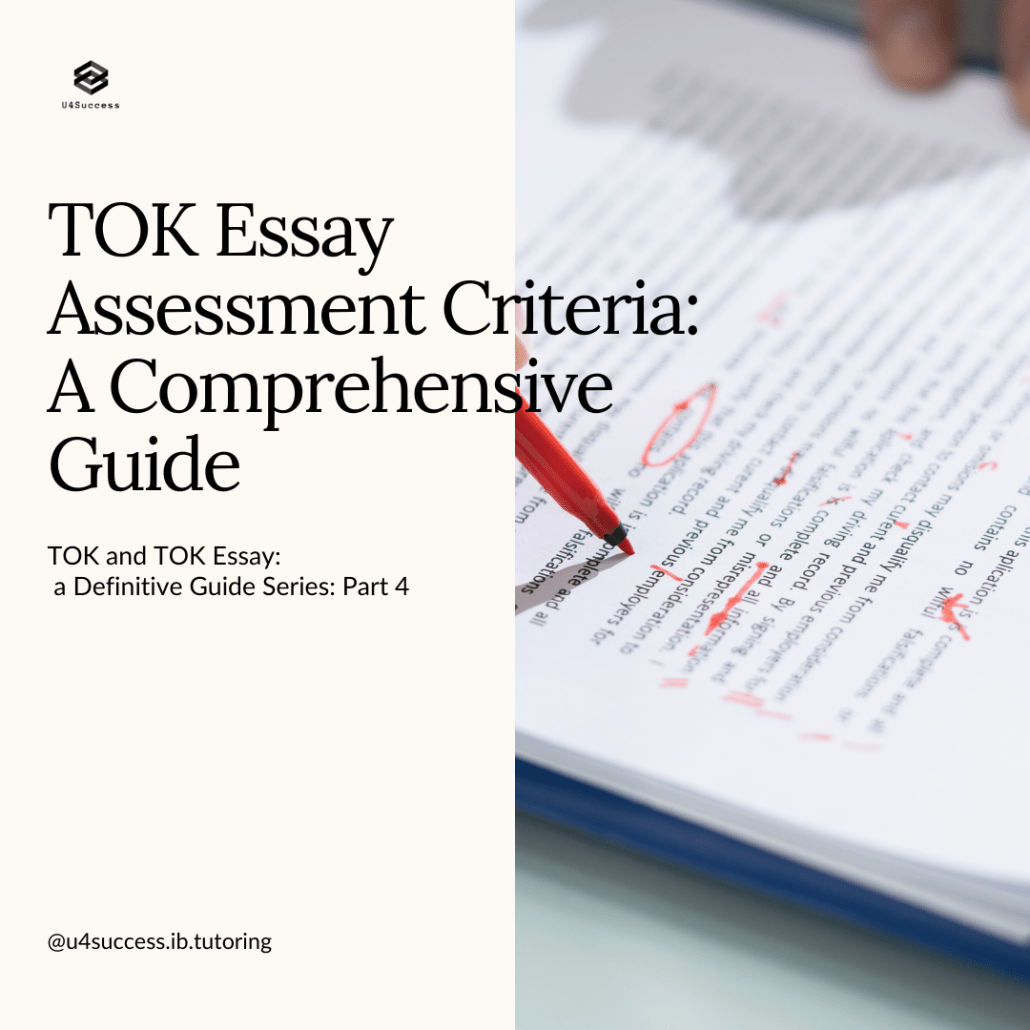
Clear, Coherent, and Critical Exploration
The primary criterion for a TOK essay is whether the student provides a clear, coherent, and critical exploration of the essay title. It is essential to maintain focus on the central question throughout your essay. By continuously relating your arguments and analysis to the essay title, you demonstrate your ability to stay on topic and present a well-developed response.
Emphasize How We Know, Not What We Know
A crucial aspect of the TOK essay is to focus on the process of knowledge acquisition rather than merely presenting factual information. Instead of providing lengthy descriptions of knowledge, your essay should explore how we acquire, produce, and pass on knowledge within the areas of knowledge. It is crucial to reflect on the methods, biases, limitations, and implications of knowledge within these areas.
Effective Use of Examples
While discussing the process of knowledge acquisition, it is essential to support your arguments with relevant examples. These examples can be drawn from subject lessons or real-life situations. By using examples, you can illustrate your points effectively and provide concrete evidence to support your claims. However, be cautious not to make your essay overly descriptive; instead, maintain a focus on critical analysis.
Coherence and Flow
A well-structured essay is coherent and allows the examiner to follow your line of reasoning. Introduce your ideas clearly and use appropriate connectives and paragraphs to enhance the flow of your writing. Ensure that your arguments are logically connected, allowing the examiner to understand the progression of your thoughts. This coherence and flow contribute to the overall quality of your essay.
Consider Multiple Perspectives
An excellent TOK essay incorporates and analyzes several perspectives on the given topic. It is vital to explore different angles and present a balanced view. Your essay should not offer a one-sided answer but should rather showcase your ability to consider multiple viewpoints. By engaging with various perspectives, you demonstrate your critical thinking skills and make your essay more compelling.
Implications and Significance
Consideration of the implications and significance of your claims is a crucial element of a strong TOK essay. When presenting your arguments or conclusions, analyze the broader implications they have for the quality, reliability, or nature of knowledge within the specific area of knowledge. Reflect on how your ideas connect to knowledge as a whole, exploring the larger implications of your claims.
Answer the Essay Prompt
Addressing the essay prompt directly is of utmost importance. Even if you manage to cover all the necessary elements required for an excellent essay, failure to answer the prompt itself can significantly impact your score. Ensure that you understand the essay question and frame your arguments accordingly. This clarity of purpose will enhance the coherence and relevance of your essay.
Concluding Remarks
Crafting a successful TOK essay requires adherence to the assessment criteria outlined by examiners. By providing a clear, coherent, and critical exploration of the essay title, emphasizing the process of knowledge acquisition, utilizing relevant examples, ensuring coherence and flow, considering multiple perspectives, and reflecting on implications, you can create a compelling essay that showcases your intellectual abilities.
Official Assessment Criteria
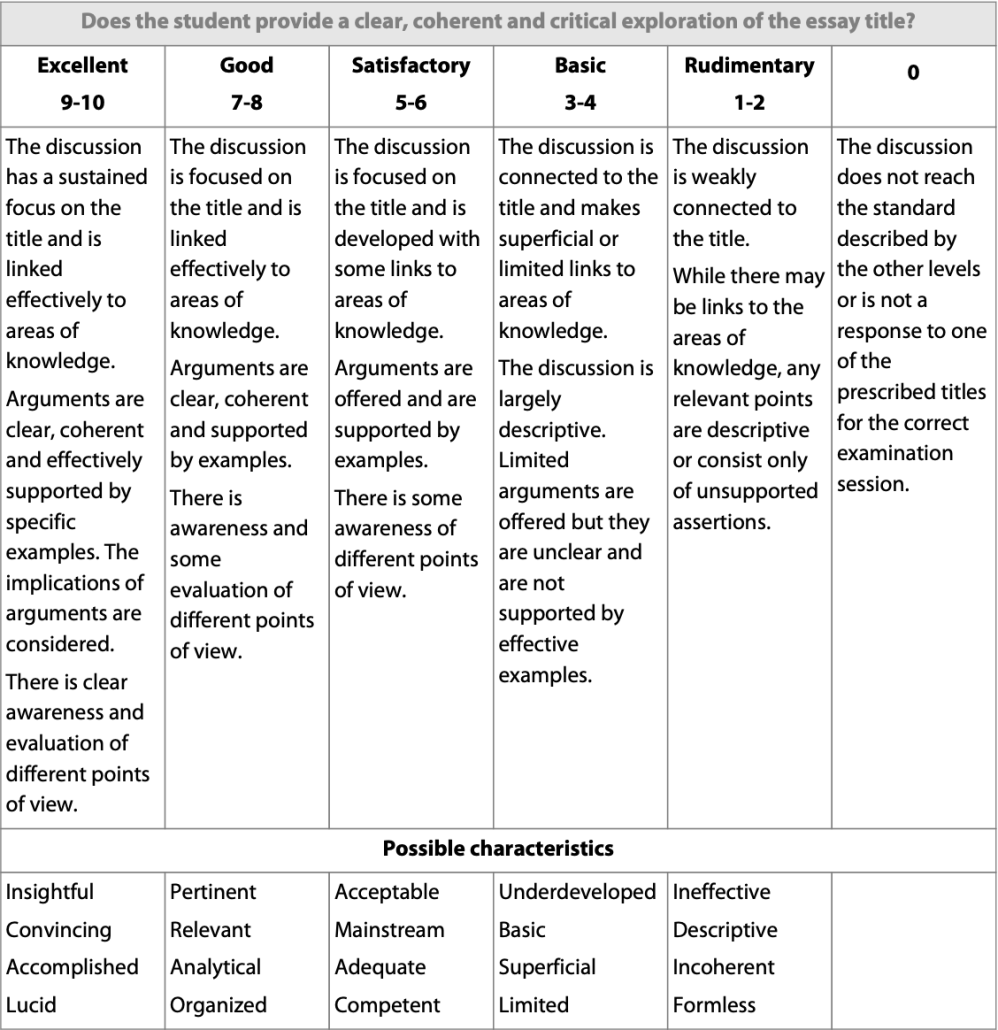
Frequently asked questions (FAQs)
Can I use personal experiences as examples in my TOK essay?
Yes, personal experiences can be used as examples in your TOK essay, as long as they are relevant and contribute to the critical exploration of the essay topic.
How many perspectives should I include in my TOK essay?
There is no fixed number of perspectives you should include. The key is to present multiple viewpoints that offer a well-rounded analysis of the topic, ensuring that your essay remains focused and coherent.
Should I include a conclusion in my TOK essay?
Yes, a conclusion is essential to summarize your main points and provide a final reflection on the essay topic. It helps bring your essay to a logical close and reinforces the overall argument.
Can I use rhetorical questions in my TOK essay?
Yes, rhetorical questions can be effective in engaging the reader and encouraging critical thinking. However, use them sparingly and ensure they contribute to the coherence and flow of your essay.
How can I ensure my TOK essay is unique and avoids plagiarism?
To maintain uniqueness and avoid plagiarism, ensure that you express ideas in your own words and properly cite any sources you reference. Take care to provide proper attribution for any quotes, examples, or evidence used in your essay.

About the Author
Anzhelika is a PhD candidate in Genetics and a marketing consultant at U4Success from Vienna, Austria. She leads our website and social media content strategy.
Share this:

Our Policies
- Terms of Service
- Terms and Conditions
- Cookie Policy (EU)
- Privacy Policy

Discover more from U4Success | IB tutoring
Subscribe now to keep reading and get access to the full archive.
Type your email…
Continue reading

IB TOK Essay examples
Type a search phrase to find the most relevant TOK Essay examples for you
Not sure what to search for? You can always look through our example Internal Assessments below for inspiration.

All TOK Essay Examples
Filter exemplars, for artists and natural scientists, which is more important: what can be explained or what cannot be explained discuss with reference to the arts and the natural sciences., does it matter if our acquisition of knowledge happens in "bubbles" where some information and voices are excluded discuss with reference to two areas of knowledge., want to get full marks for your tok essay allow us to review it for you 🎯, is replicability necessary in the production of knowledge discuss with reference to two areas of knowledge., are visual representations always helpful in the communication of knowledge discuss with reference to the human sciences and mathematics., fast track your coursework with mark schemes moderated by ib examiners. upgrade now 🚀, to what extent is the knowledge we produce determined by the methodologies we use discuss with reference to history and one area of knowledge., tok essay: 5. “how can we distinguish between good and bad interpretations discuss with reference to the arts and one other area of knowledge”, 如果我们是在排除某些信息和声音的“信息同温层”里获取知识,这有关系吗请参考两个知识领域展开你的应答。, does it matter if our knowledge acquisition happens in "bubbles" where some information and voices are excluded discuss with reference to two areas of knowledge., is replicability necessary in the production of knowledge discuss with reference to two areas of knowledge, do you agree that it is “astonishing that so little knowledge can give us so much power” (bertrand russell) discuss with reference to the natural sciences and one other area of knowledge., does it matter if our acquisition of knowledge happens in “bubbles” where some information and voices are excluded discuss with reference to two areas of knowledge., to what extent is the knowledge weproduce determined by the methodologieswe use, for artists and natural scientists, which is more important: what can be explained or what cannot be explained discuss with reference to the arts and natural science., êtes-vous d'accord qu'il est "étonnant que si peu de connaissance puissent nous donner autant de pouvoir" (bertrand russell) - discutez cette question en faisant référence aux sciences naturelles et à un autre domaine de la connaissance, est-il important que notre acquisition des connaissances se fasse dans des « bulles » où certaines informations et certaines voix sont exclues discutez cette question en faisant référence à deux domaines de la connaissance., to what extent is the knowledge we produce determined by the methodologies we use discuss with reference to history and one other area of knowledge., is replicability necessary in the production of knowledge discuss with reference to two area of knowledge, are visual representations always helpful in communicating knowledge discuss with reference to the human sciences and mathematics., are visual representations always useful in communication of knowledge discuss with reference to the human sciences and mathematics., for artists and natural scientists which is more important: what can be explained or what cannot be explained, is replication necessary in the production of knowledge discuss with reference to two aoks., do you agree that it is "astonishing that so little knowledge can give us so much power" (bertrand russell) discuss with reference to the natural sciences and one other area of knowledge., is replicability necessary in the production of knowledge.
Writing & uploading the TOK essay
TOK Home > Free TOK notes > TOK essay guidance > Writing & uploading the TOK essay
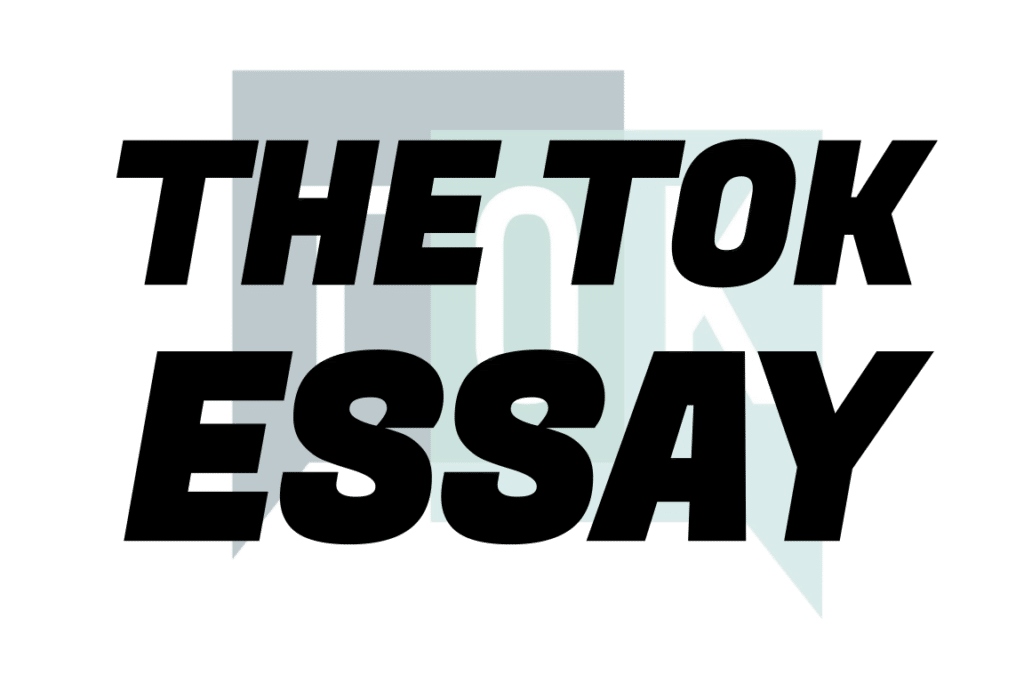
After you have grasped the essay rubric , chosen your title , and have a clear plan and structure , you can start writing your TOK essay. You’ll be doing this alongside the three interactions, so keep these in mind as you proceed.
Read the points below to get some advice on how to write your essay, and avoid common mistakes made by students.
STEP 4: Write and upload your TOK essay
Get started.
The most important part of writing your essay is getting started. You can procrastinate for ages, thinking about whether you’ve chosen the right title, which areas of knowledge to explore the question in, key thinker and ides to draw on, and so on. Obviously you need to choose the right title, and have an effective plan, but this means nothing until you have put your thoughts down on paper. You will find that many of your uncertainties start to resolve themselves when you start writing.
The introduction is all important
Your introduction should begin with a ‘hook’ to engage the reader, offer your interpretation of the key words or ideas from the title (don’t just copy a definition out of a dictionary – give your take on what the title means), outline the scope of the essay. Get your introduction right, and you will have set up the foundations for a great essay. If you rush it, or not view it with the importance it really requires, you’ll struggle to develop clear ideas in the main body of the essay.
Follow a clear essay plan
By two, you should have formulated a clear essay plan. This means knowing which AOKs you are using as the context of the essay, the arguments and counterarguments you’ll be presenting, the real-life examples you’ll be drawing on to justify discussion points, how you’ll indicate the implications of your arguments, and the way in which you’ll challenge assumptions in the question. Agree with your teacher on this plan, and let them know if you are deviating significantly from it.
Justify each point you make
Each of the discussion points you make should be supported by a real-life example. These can come from your own experiences as a knower (inside, and outside of the school), or from events, issues, and topics you’ve read about or encountered from the news and other media sources.
Don’t jump straight into your examples
A common mistake made by students is to move straight onto real-life examples without offering a proper discussion about knowledge. Discuss your own take on the question, perhaps referring to a key thinker or theory, before relating this to a real-life situation.
Consider counterarguments
You need to offer a consideration of different points of view, and the way to do this is via counterarguments. For each of your claims or arguments, you should offer a counterclaim or counterargument, weighing up how the issue could be considered from another point of view. Make sure you evaluate these counterarguments, and don’t just mention them.
Find your own voice
Make sure that you offer your own opinions, give your own interpretation of the title, and offer your own experiences to support your arguments. This will demonstrate your skills as a critical thinker, and distinguish your essay from those that rely on generic and cliched discussions.
Make full use of the interactions
In order to develop your ideas, and ensure that you’re on the right track with your essay, make sure you make full use of the with your teacher. It’s during these one-to-one sessions that you can discuss your arguments, evaluate your examples, and consider which key thinkers and concepts work in your essay.
Don’t neglect the non-assessed elements
Make sure that you format your essay in the right way, offer a decent bibliography, hit the word limit (without going over it), and follow all the other protocols for submitting your TOK essay. This will present a great impression to examiners, and show that you are ready and willing to follow the IB requirements for the assessment task.
A four-step guide to the TOK essay
Click on the buttons below to take you to the four steps of creating a great TOK essay. Don’t forget that we have plenty of videos on this and other aspects of the course, and members of the site have access to a huge amount of other resources to help you master the course and assessment tasks.
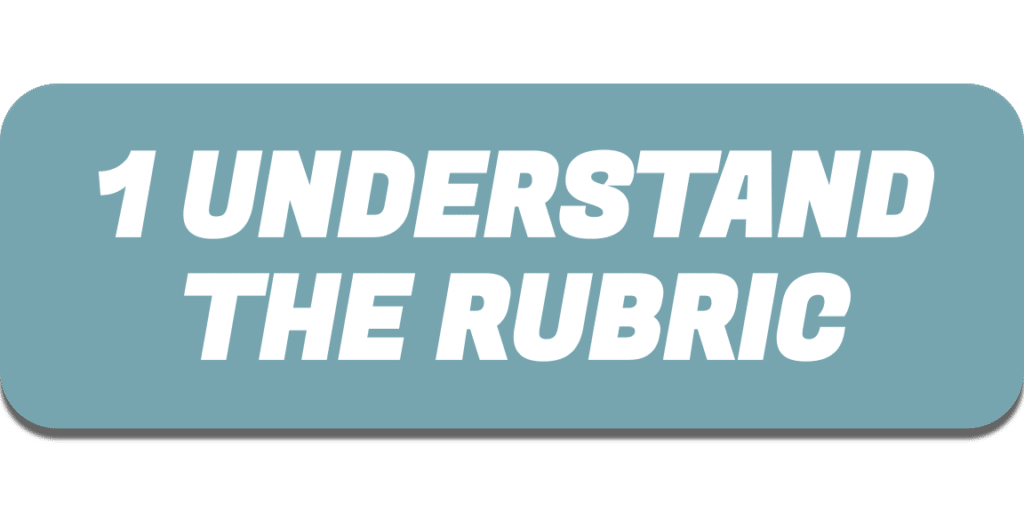
Check out our three-minute explainer video on the TOK essay here . The video goes over the basics of the TOK essay, such as how it’s assessed, the word count and other practical details, terms such as ‘perspectives’ and ‘implications’, and the role of real-world examples in justifying claims and arguments.
You’ll find more videos on this and other aspects of TOK here , and you can dive into much more depth via our free and premium webinars, here .
Watch our essay & exhibition webinars
Click on the images below to access these premium webinars on how to create the essay and exhibition. Access more webinars here , and watch our videos on the assessment tasks on this page .
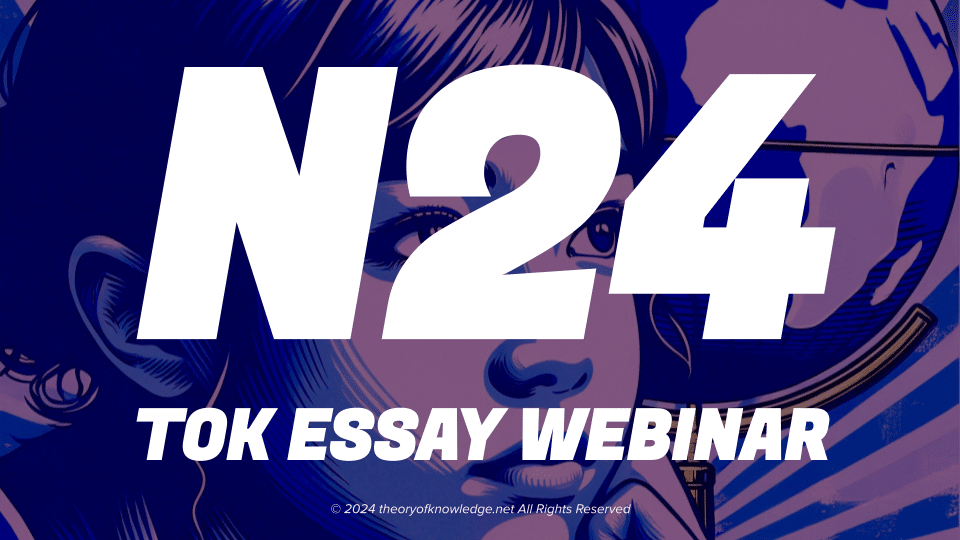
FAQs about the TOK essay
How do i choose my tok essay title.
You choose your essay from six prescribed essay titles, that are released at the beginning of your second DP year. We give a few tips on how to choose a PT that will work for you here . But briefly, choose one that links to your pre-existing knowledge, and that you find personally engaging.
What will I be writing about in my TOK essay?
You’ll be answering your prescribed title, within the context of two areas of knowledge, considering how different perspectives might affect our response to the question, and what the implications of your arguments are.
Can I use ChatGPT to write my essay?
You can use ChatGPT to help you gather materials for your essay, but you should definitely not be using it to write the essay. Be very careful with ChatGPT. It bases its answers on online material, and much of this is inaccurate or out-of-date. For example, depending on what you ask it, it may tell you that you have to explore multiple areas of knowledge (rather than the two stipulated by the titles), and that you have to identify a separate knowledge question to the title (which is absolutely not the case).
How much help should I expect from my teacher?
Your teacher should run through the PTs when they are first released, and then meet you for three interactions, during which you’ll discuss your progress. They are allowed to give you one set of written feedback. But you can consult them at other times with specific questions.
Do I need to use real-world examples in my TOK essay?
Yes, real-life examples help illustrate your points and make your arguments more tangible. They can be drawn from personal experiences, historical events, scientific discoveries, etc.
Should I include my personal opinion in the TOK essay?
While the TOK essay is not about your personal opinion per se, it’s important to reflect on your perspective and how it shapes the way you understand the title. However, you should avoid using the essay as a platform for rants or unsubstantiated claims.
Is it necessary to include counter-arguments in my TOK essay?
Yes, including counter-arguments shows a deeper understanding of the complexity of the topic and demonstrates your critical thinking skills. It also enables you to consider different perspectives, and evaluate the implications of arguments.
Should I include the 12 key concepts in my essay?
Yes, as much as you can, draw on the key concepts such as justification, evidence, perspective, bias, certainty, and objectivity within your arguments linking them to the title, and to the real-world examples you draw on.
How do I ensure that my TOK essay reflects my own original thinking, and avoids plagiarism?
Clearly attribute ideas and sources that are not your own, and strive to present original insights and interpretations supported by evidence and reasoning. See our point above on using ChatGPT – never view this as more than a tool to help you gather material for your essay, rather than a tool to write it for you.
What are some common pitfalls to avoid when writing a TOK essay?
Avoid oversimplifying complex issues, relying solely on personal opinion without justification, neglecting counter-arguments, veering off the question, and failing to include a consideration of different perspectives.
How long do I have to write my essay?
You’ll have 6 months from the time the prescribed titles are released, to the deadline date for uploading your essay to the IB. However, most schools will set their own deadline for completing the essay, so that everyone has plenty of time to complete your PPF, and upload it on time. Follow what your school tells you about this.
How important is the TOK essay PPF?
The PPF (‘Planning and Progress Form’) is the document that you fill in to outline your discussions during the three essay. Although this is not directly assessed, it is an important part of demonstrating that you have approached the TOK essay in an ethical way, which is now particularly important in the era of ChatGPT.
What are some effective strategies for revising and editing my TOK essay to improve clarity and coherence?
Take breaks between revisions, seek feedback from peers or teachers, and carefully proofread for grammar, punctuation, and coherence.
Should I include references or a bibliography in my TOK essay?
While not required, referencing sources appropriately adds credibility to your essay; use footnotes or endnotes for citations.

Subscribe to the free TOK newsletter!
Subscribe to our free newsletter, and collect fantastic examples that will help you to understand the key ideas of TOK, support your essay and exhibition discussions, and help you to become an authentic critical thinker .
You’ll encounter some of the most important thinkers from the past and the present, go beyond the headlines of contemporary events and issues around the globe, and see how TOK concepts manifest in the real-world. Subscribe HERE !
Baby Reindeer creator asks fans to stop hunting down the real people from the Netflix show
Baby Reindeer, the Netflix limited series from comedian Richard Gadd, has become an unlikely hit for the streaming service. In two weeks on the platform the series racked up 52,800,000 hours watched. It's currently the most watched TV title globally.
Warning: This article discusses trauma, mental illness and spoilers for Baby Reindeer.
The true story is centred around struggling comedian Donny Dunn (a narrative stand-in for Gadd) who enters into a tangled relationship with Martha, a stalker who would end up sending him 40,000 emails and leaving hundreds of hours of voice messages over a few years.
Critically, Baby Reindeer is being praised for how skilfully it unpacks trauma and prods uncomfortably at the audience's need for an evil villain and a perfect victim.
But in the short time since the series release, online sleuths have launched a mission to find the "real Martha" without regard for the living people behind the unbelievable true story.
It's gotten so bad that Gadd took to his Instagram story to request fans stop their speculation.
What is Baby Reindeer about?
Baby Reindeer begins with a kind gesture. Donny is working in a pub while waiting to strike gold with his comedy. Martha (Jessica Gunning) comes in one day with ruddy cheeks and a big smile, but not enough money to afford a drink. Donny makes her tea on the house and thus starts a warped and sometimes physically dangerous connection between two people.
Martha starts coming into the pub every day to tell Donny fantastical lies about her career as a lawyer to the stars. She lavishes attention on Donny that is not entirely rejected. Martha begins to send Donny dozens of emails a day, they take a darkly sexual turn after Donny is peer pressured into lewd banter by his brash workmates.
For seven episodes Donny and Martha continue their disturbing dance, with the former always insisting he demands distance. But whether by a sense of guilty sympathy or a need for adoration, Donny keeps Martha revolving around his unsatisfying life.
At the same time Donny is grappling with uncomfortable emotions that arise when he begins dating Teri (Nava Mau), a trans woman.
Donny's decisions that keep Martha around while also alienating Teri seem baffling, until you arrive at episode four. Through flashbacks we see Donny's first trip to the Edinburgh Fringe Festival, an event that's notorious for making and breaking comedians in the industry.
With bracing honesty and using Donny as a proxy, Gadd shares that he was groomed and repeatedly sexually assaulted by a powerful man that promised him the keys to the industry.
The rest of the series revolves around Donny finally removing himself from Martha's grasp and also coming to grips with the trauma lying in his past.
Is Baby Reindeer a true story?
Yes, but with a caveat. Gadd did indeed deal with an older woman who stalked him for a period of six years, leaving him 41,071 emails, 744 tweets and 350 hours of voicemails.
Gadd used this as inspiration for his 2019 one-man show of the same name, which was so critically and commercially successful that it was set for a run in the London West End before COVID ruined the plan.
Gadd told Variety that Baby Reindeer is "emotionally 100% true" but that characters had been altered for legal reasons.
The comedian expanded on these comments to GQ , saying that such lengths had been taken to disguise Martha, her real life counterpart wouldn't recognise herself.
Gadd also pulled on his 2016 show Monkey See, Monkey Do where he first detailed the experience of his grooming and assaults while running on a treadmill trying to escape an invisible monkey. It won the Edinburgh Festival Award for Best Comedy Show that year.
Trauma shared with millions
In his promotion of the show, Gadd has gone to great lengths to explain that Baby Reindeer is not a black-and-white cautionary tale or a "victim narrative".
"I think art is quite interesting when you don't know who you are on the side of. I wanted it to be layered, and I wanted it to capture the human experience," he told Netflix.
"The human experience is that people are good, but they have bits of bad and they make mistakes."
Clinical and forensic psychologist Dr Ahona Guha says that narrative depictions of trauma like Baby Reindeer can allow survivors to reckon with their own experiences.
"It can be a way of finding solidarity and learning from other people who have experienced and survived the same thing," Dr Guna says.
"We all need mirrors for ourselves, and media depictions can support this process."
Dr Guna says that Baby Reindeer nailed "the fear, hyper vigilance and anxiety" that come from being stalked and the mind frame of someone who feels compelled to stalk.
"While we didn't learn too much about Martha's backstory and her mental health difficulties it provided a compelling view into the way in which mental illness — such as erotomaniac beliefs, or the delusion that someone loves you — can drive offending behaviours," she says.
But there are ethical concerns when broadcasting such a story to a mass audience.
"As a psychologist, I would always be concerned about things like identification, ensuring a sensitive and accurate portrayal and not presenting mental illness, trauma or victimisation as a joke or light entertainment," Dr Guna says.
Hunting down 'the Real Martha'
At the time of writing, if you plug Baby Reindeer into Google Trends three names will pop up as the top searches from the last week.
They are all women that numerous social media users have identified as "the real Martha". Multiple TikToks with millions of views and tens of thousands of likes dredge up old tweets and court cases to validate their finger pointing.
"I suspect this is driven by a desire to know more and simple unchecked curiosity, or a misplaced desire for retribution without recognition that the destabilisation caused to someone by being hunted down like this might be quite profound," Dr Guha says.
This kind of complete blame is in direct antithesis to the sympathy Baby Reindeer affords Martha even as she commits abhorrent acts. At one point after assisting a freezing and disoriented Martha home, Donny clocks the grubby law degree attached to the fridge in Martha's festering hovel. It's a heart wrenching indicator of a promising life derailed by illness and a confirmation that Martha is also suffering.
"There's nothing to be gained and no further answers to be elicited from the real Martha, and it's ethically very problematic if people try to track her down," Dr Guna says.
"It's important to recognise that these are real lives being portrayed here, and to treat this with dignity, instead of as simple entertainment."
But it's not just the real Martha the internet desperately seeks, it's the real Teri and the real Darrian, the high-profile figure that assaulted Gadd in real life. Internet detectives soon falsely accused British director Sean Foley of being the real life Darrian. The accusations got so strong that Gadd had to publicly dispel the rumours.
"Please don't speculate on who any of the real life people could be. That's not the point of our show," Gadd shared to his Instagram stories.
Hours later Foley confirmed that police were investigating the "defamatory, abusive and threatening posts" made about him.
Dr Guna says that humans have a bias to split things into "good" and "bad" and when people perpetrate offences it's tempting to write them off as wholly evil.
"The reality is that offending happens for a wide range of reasons and many of us would behave in a similar way in the right confluence of circumstances," she says.
"Believing that a perpetrator is somehow 'bad' and fatally flawed allows us to separate from our own faults and flaws and gives us an illusory sense of safety and comfort.
"We tend to forget that people can be victims and perpetrators, and that many people who hurt others have been hurt themselves in a range of ways."
In an essay written for Netflix , Gadd expresses the fear he felt when he was first performing Baby Reindeer for live audiences. He worried that people wouldn't believe him, would say he encouraged Martha, that his sexual assault wouldn't be seen as 'valid' but feedback confirmed that crowds were as morally confused and moved by his story as he was.
"All I ever wanted to do was capture something complicated about the human condition," Gadd says.
"That we all make mistakes.That no person is ever good or bad. That we are all lost souls looking for love in our own weird way."
- X (formerly Twitter)
- Arts, Culture and Entertainment
- Mental Health
So Your High School Doesn’t Offer APs—Are AP Exams Still Important For College Admissions?
- Share to Facebook
- Share to Twitter
- Share to Linkedin
Brown University
Advanced Placement courses are offered at thousands of high schools across the U.S.— approximately 35% of public high school graduates in the Class of 2023 took at least one AP exam, and approximately 2.8 million students sat for AP exams in 2023. However, a large number of schools do not offer AP courses. In many cases, this is due to a lack of resources—though strides have been made to increase access to AP courses in underprivileged schools, a gap in access persists along racial and socioeconomic lines. In other cases, schools are ditching the AP curriculum as a result of their educational philosophy. In 2018, elite private schools in the D.C. area such as Sidwell Friends and Georgetown Prep announced their intention to phase out AP classes, citing their desire for a more independent curriculum and a growing frustration with the AP’s orientation toward testing rather than other metrics for success.
Despite these drawbacks, AP courses and exams remain highly regarded by many colleges and universities, as they offer insight into students’ academic acumen and potential to complete college coursework successfully. As a result, many students without access to AP courses are left wondering whether they should still register, study and sit for AP exams.
First and foremost, students should know that colleges and universities evaluate their applications in the context of their school and the opportunities available to them. This means that if students did not have AP classes available to them at their schools, admissions officers will not expect to see AP courses or AP exam scores included in their applications. As such, these students’ applications will not be disadvantaged in any way by not including AP exams.
That being said, there are some scenarios in which a student may still wish to take an AP exam despite not having taken an AP course. These are the top three reasons that students might consider sitting for one or more AP exams:
1. To Earn College Credit
One of the main reasons students take AP exams is to earn college credit. Many colleges and universities grant credit for high AP exam scores (typically for 4s or 5s). By earning credit through AP exams, you may be able to fulfill prerequisites, skip introductory courses, or accelerate your progress toward graduation once you enroll in college. However, this is not the case at every school. In order to determine whether the time and effort you will put into studying and taking an AP exam will be justified, you should research whether the schools you are considering applying to give college credit for high AP exam scores. You can often find this information on admissions or departmental websites, or by contacting admissions representatives at each respective school. You can also check the College Board website to see if the schools on your list accept AP credits, but note that these policies change frequently, so you should still follow up with the schools for verification. If a handful of the schools on your list do accept high scores for credit, it may be a strategic choice to sit for one or more exam.
Huawei’s Pura 70 Ultra Beats iPhone With Pioneering New Feature
Sh gun episode 10 review a powerful finale but not what i was expecting, the trump media stock price djt is about to adjust down by 22 7, 2. to use exam scores in lieu of the sat or act.
As Ivy League and other top schools reinstate their standardized testing requirements, some schools have announced their intention to allow students to submit test scores from AP examinations in place of ACT or SAT scores. Dartmouth allows students applying from schools outside of the U.S. to satisfy their testing requirement by submitting three AP exam scores. Meanwhile, Yale’s new test-flexible policy also allows students applying domestically to submit AP and IB scores in lieu of other standardized tests. If you are applying internationally or if you have reason to believe that you will achieve a stronger score on AP exams than on the SAT or ACT, you can consider sitting for the exams. Note that not all schools have such flexible testing policies, so you will likely still need to sit for the SAT or the ACT.
3. To Demonstrate Your Academic Abilities
It is important to remember that while they are not the only way to demonstrate their academic capabilities, AP exams are an unbiased and quantifiable way to assess students’ preparedness for college coursework. Students who struggled academically earlier in their high school years or who want to highlight their skills in a specific discipline may benefit from the inclusion of AP scores in their applicant profiles.
Finally, while students who do not have access to AP classes should consider their options and make a strategic decision about taking exams on the basis of their applicant profiles and academic goals, students who have taken AP courses absolutely should take AP exams. Failing to sit for the exams will not only foreclose the possibility of earning college credit, but it will also reflect poorly on your application and raise questions with admissions committees.

- Editorial Standards
- Reprints & Permissions

IMAGES
VIDEO
COMMENTS
Theory of knowledge (TOK) is assessed through an exhibition and a 1,600 word essay. It asks students to reflect on the nature of knowledge, and on how we know what we claim to know. TOK is part of the International Baccalaureate® (IB) Diploma Programme (DP) core, and is mandatory for all students. Learn more about theory of knowledge.
Paragraph 1. - Say one or two interesting things about the prescribed title question. This shows us, right away that you know what the question is asking. - Define one or two of the key terms in the title. Get definitions for all of the main words in your title. You don't need to include all of them in your essay, but it's useful to see how ...
Tell students that TOK essay is a "formal, sustained piece of writing" in response to one of six prescribed titles. It is externally assessed, with twice the weighting of the Exhibition. ... Teachers are expected to explain the requirements of the task and ensure that students are familiar with the assessment instrument, provide ...
There are two assessment tasks in the TOK: an essay and a presentation. While a presentation encourages students to explore a real-life situation through the lens of TOK, an essay is written on the basis of the various questions provided by the International Baccalaureate Organisation. The presentation is to assess a student's ability to ...
Once you've grasped the essay rubric, and chosen your title, you can start planning and structuring your TOK essay. You base this around the 3 interactions with your teacher, which are one-on-one meetings discussing your progress, and receiving feedback. As well as the interactions, you can also ask your teacher specific questions about your ...
Beyond the basics (making sure you address the essay title as well as the TOK assessment instrument), there are additional requirements for the TOK essay. Check the TOK subject guide for details. Academic honesty / authenticity: Page 44 of the TOK subject guide is quite clear: "The TOK essay must be the student's own work."
Download Article. 1. Use your essay outline as a guide. Focus on expanding each section of your outline, keeping in mind the 1200-1600 word limit for the essay. Your introduction and your conclusion should be the shortest paragraphs in your essay, and the body paragraphs should be the longer sections of your essay.
A well-structured TOK essay should be composed of four parts: an introduction, the body, a conclusion and a bibliography. In the introduction, you should define TOK and explain how it forms part of the IB curriculum. The body should include arguments and justifications with evidence from multiple AOKs.
Overview of TOK Essay strategy. Here are the six cumulative sections: Unpack your prompt. Reconnect with the 5 Areas of Knowledge. Focus on your essay format. Using the TOK Framework to refine your planning. Returning to the Rubric. Finessing the quality of your analysis.
The following guide will provide you with an overview of what examiners look for in a TOK essay before breaking down the steps you need to take to complete yours to a high standard. Your essay will be marked by an external IB examiner and given a score out of 10. These 10 points are divided into 5 levels, ranging from 'excellent' to 'rudimentary'.
There is a maximum TOK essay word count of 1,600 words. This strict limit requires students to articulate their thoughts clearly and concisely. The essay is assessed using criteria that evaluate students' ability to identify and research knowledge issues, contrast TOK key concepts, demonstrate critical thinking, and organize their ideas ...
Generally no …. TOK examiners tend to be quite dismissive of essays that argue either that we can't know anything at all or that you can have your 'truth' and I can have my 'truth' and that these truths are both true. The first of these approaches is often called 'lazy scepticism' and the second 'easy relativism' and you can ...
The International Baccalaureate (IB) doesn't prescribe a single structure for the ToK Essay. They require that you " provide a clear, coherent and critical exploration of the essay title " (IB ToK Essay Assessment Instrument, 2020) Achieving this requires a well-thought-out structure that fosters clarity, coherence, and critical exploration.
10 TOK essay starting points. 1 The TOK essay is an individual task. 2 It represents two thirds of the overall mark for TOK. 3 It is externally marked. 4 You choose your title from a list of six prescribed titles, which change every exam session. 5 The word count for the essay is 1600 words.
The DP curriculum is made up of six subject groups and the DP core, comprising theory of knowledge, creativity, activity, service, and the extended essay. A candidate must take and complete the assessment components for six subjects, together with these core elements: theory of knowledge (TOK) the extended essay (EE) creativity, activity ...
Tips for writing an exhibition essay in mind. 1. Don't neglect what the ToK essay title is asking of you, and make sure you identify and understand the key terms. These terms will be your essay's anchor and can help you write content that gravitates around them. Brainstorm with your ToK coordinator, if required.
the year of your graduation. Also, read for detailed explanations of the essay requirements in the most recent TOK Curriculum Guide; what follows are my own suggestions and guidelines based on the information in the guide. ***** PREPARING THE ESSAY---GENERAL TIPS: 1) Make your introduction clear; lay out a roadmap of wear you plan to take the ...
After understanding the of the basics of the essay, your next step is to grasp how it is evaluated and marked, which is outlined in the 'assessment instrument'. Your TOK teacher will give you a copy of this, or you can find it online in the 2022 TOK Guide. The overall assessment objective of the TOK essay is to answer the prescribed essay title in a clear, coherent, and critical way.
The primary criterion for a TOK essay is whether the student provides a clear, coherent, and critical exploration of the essay title. It is essential to maintain focus on the central question throughout your essay. By continuously relating your arguments and analysis to the essay title, you demonstrate your ability to stay on topic and present ...
General information about the essay: Your TOK essay counts for most of the marks. It it is worth 67% of your final TOK grade. You will get the choice between a set of prescribed essay titles. These essay titles are all, in some way, related to the Areas of Knowledge. They will formulated as knowledge questions.
Are visual representations always helpful in the communication of knowledge? Discuss with reference to the human sciences and mathematics. TOK Essay A. TOK Essay: 5. "How can we distinguish between good and bad interpretations? Discuss with reference to the arts and one other area of knowledge".
Make sure that you format your essay in the right way, offer a decent bibliography, hit the word limit (without going over it), and follow all the other protocols for submitting your TOK essay. This will present a great impression to examiners, and show that you are ready and willing to follow the IB requirements for the assessment task.
The TikTok bill that passed the House over the weekend isn't just a high-profile shot at an ultra-popular app — it's a historically unusual move that in itself could create problems for the ...
Baby Reindeer, the Netflix limited series from comedian Richard Gadd, has become an unlikely hit for the streaming service. In two weeks on the platform the series racked up 52,800,000 hours watched.
But for the most part, the disappearing stockmarket is a side-effect of something more positive for company founders: they simply have more options. Private-equity funds managed $8.2trn by the ...
Advanced Placement courses are offered at thousands of high schools across the U.S.— approximately 35% of public high school graduates in the Class of 2023 took at least one AP exam, and ...